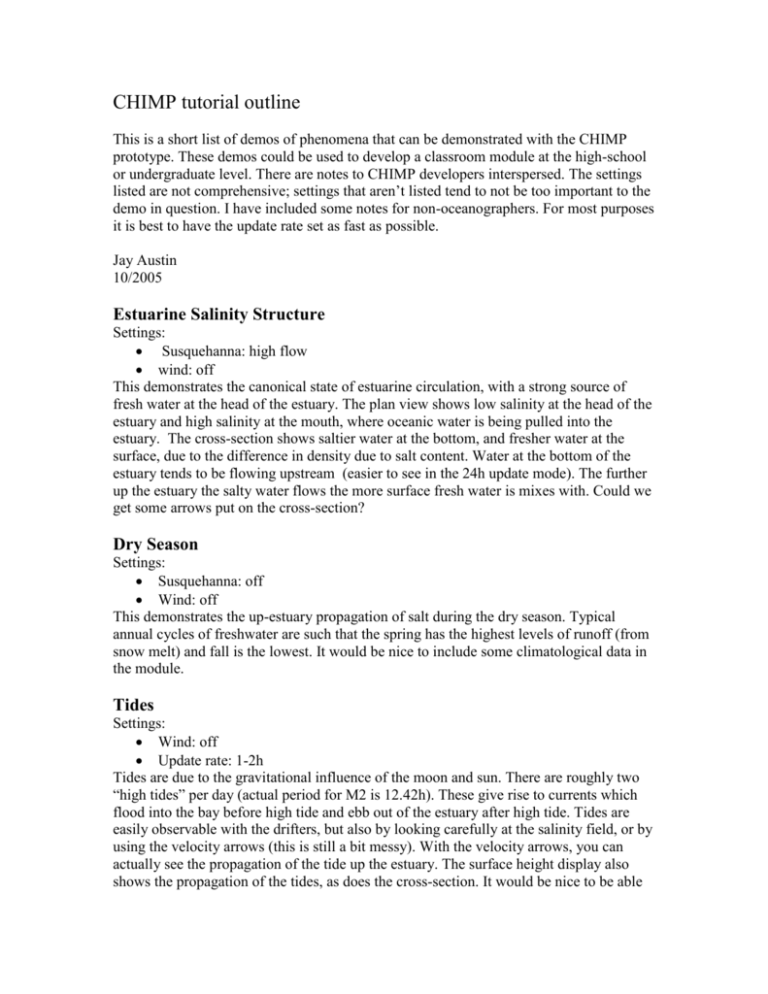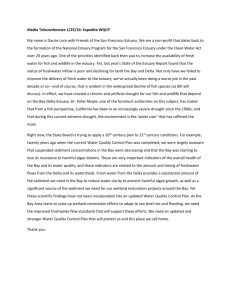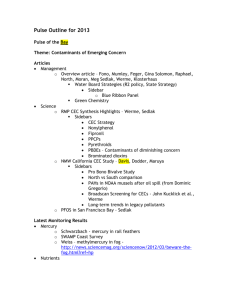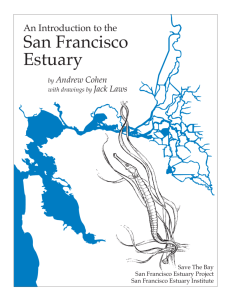CHIMP tutorial outline
advertisement

CHIMP tutorial outline This is a short list of demos of phenomena that can be demonstrated with the CHIMP prototype. These demos could be used to develop a classroom module at the high-school or undergraduate level. There are notes to CHIMP developers interspersed. The settings listed are not comprehensive; settings that aren’t listed tend to not be too important to the demo in question. I have included some notes for non-oceanographers. For most purposes it is best to have the update rate set as fast as possible. Jay Austin 10/2005 Estuarine Salinity Structure Settings: Susquehanna: high flow wind: off This demonstrates the canonical state of estuarine circulation, with a strong source of fresh water at the head of the estuary. The plan view shows low salinity at the head of the estuary and high salinity at the mouth, where oceanic water is being pulled into the estuary. The cross-section shows saltier water at the bottom, and fresher water at the surface, due to the difference in density due to salt content. Water at the bottom of the estuary tends to be flowing upstream (easier to see in the 24h update mode). The further up the estuary the salty water flows the more surface fresh water is mixes with. Could we get some arrows put on the cross-section? Dry Season Settings: Susquehanna: off Wind: off This demonstrates the up-estuary propagation of salt during the dry season. Typical annual cycles of freshwater are such that the spring has the highest levels of runoff (from snow melt) and fall is the lowest. It would be nice to include some climatological data in the module. Tides Settings: Wind: off Update rate: 1-2h Tides are due to the gravitational influence of the moon and sun. There are roughly two “high tides” per day (actual period for M2 is 12.42h). These give rise to currents which flood into the bay before high tide and ebb out of the estuary after high tide. Tides are easily observable with the drifters, but also by looking carefully at the salinity field, or by using the velocity arrows (this is still a bit messy). With the velocity arrows, you can actually see the propagation of the tide up the estuary. The surface height display also shows the propagation of the tides, as does the cross-section. It would be nice to be able to generate and display a time series of a property from a location in the bay. Tidal currents at the mouth of the bay are on the order of 1m/s (2mph). Tides are important for determining the level of mixing in an estuary. Influence of winds: currents Settings: Wind: off; direction: N Update rate: 1-2h Turn the display to the drifters, which are wiggling back and forth with the tides. Turn the wind speed up (high) such that the wind is blowing strongly to the north. The drifters are all displaced to the south, but eventually reach an equilibrium location around which they wiggle with the tides. Note on the cross-section that the surface height is depressed when the wind blows out of the N. Likewise, if the wind blows from the S, the drifters are displaced to the N and the Bay fills with water. This is what causes flooding during a storm. Influence of winds: mixing Settings: Wind: off Susquehanna: high With the wind off, significant stratification (layering) builds up throughout most of the bay, best seen in the cross-section. When the wind is turned up (high, direction is largely unimportant) we see that the layers are washed away, and at any location the whole water column takes on a salinity between the original surface and bottom salinities. The stronger the wind, the quicker this mixing takes place. During the summer, we have very few strong wind events, and the stratification in the central bay becomes quite strong. This isolates the bottom layer away from the surface, so that it is not in contact with the atmosphere. Combine this with bacterial decomposition of detritus, and the oxygen can be depleted in the lower layer of water. This is known as hypoxia (low oxygen) or anoxia (no oxygen) depending on how severe it is, and makes the bay uninhabitable for fish and other animals. A severe storm can mix the water column and provide oxygen to the whole bay. Plume structure Settings: Wind: off Susquehanna: high When fresh water leaves the estuary, it tends to turn to the right and move along the coast as a plume. Water off of Virginia Beach tends to be water that has recently left the Bay. This phenomenon can also be demonstrated by turning off the Susquehanna for a while, let the bay get salty, and then turn on the Potomac. The freshwater plume from the Potomac also tends to turn south inside the bay. This is due to the rotation of the earth. This also accounts for the fact that water on the east side of the bay tends to be somewhat saltier than the west side. Upwelling and downwelling Settings: Wind: off Potomac plume developed Once the Potomac plume is somewhat developed, blow the wind gently from the north. The plume should tighten up against the shore to the S of the mouth of the Potomac. This is due to Ekman transport in the surface layer, where surface waters tend to want to travel to the right of the direction of the wind. In this case, surface waters in the central bay move west, squishing the plume against the shore. If you blow the wind gently from the S, the plume gets spread out into the bay as the surface waters move east.










